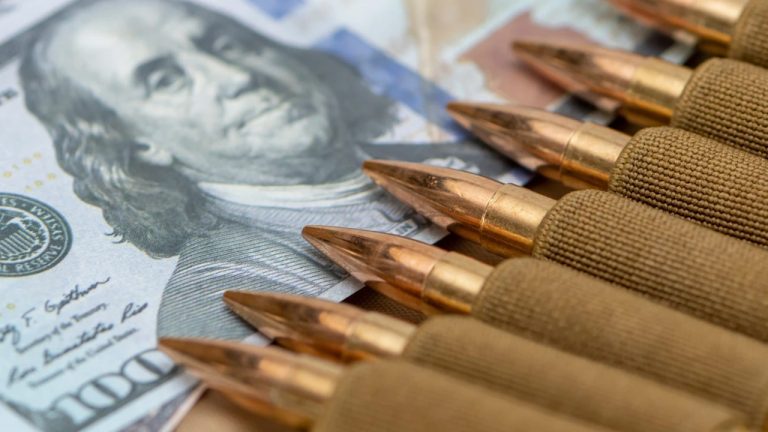
When Satoshi Nakamoto created Bitcoin, many viewed it as a solution to the drawbacks of fiat money. Historically, about 800 fiat currencies have come and gone, with many ultimately failing. Intriguingly, the fundamental reasons for establishing the fiat system remain elusive to many. Some argue that it was designed by governments to perpetuate corruption and fund endless global conflicts. In a nutshell, most fiat currencies have either supported military pursuits or protected financial magnates who benefit from such endeavors.
Unraveling the Shadows: The War-Driven Legacy of Fiat Currencies
Notably, U.S. presidential hopeful Robert Kennedy Jr. recently remarked, “fiat currency was invented to fund the cause of war.” A bold claim, but history does lend credence to Kennedy’s assertion. Ages ago, people traded with commodities and precious metals fashioned into coins. This practice shifted during the Yuan Dynasty in China (1271-1368 AD) under Kublai Khan.
Fiat currency, in essence, is government-issued money not anchored to a tangible commodity like gold or silver. Its worth stems from the citizens’ trust and faith. Unlike commodity money, grounded in its material, or representative money, signifying a claim on a commodity, fiat money gains its value through government backing. The Yuan Dynasty’s “Jiaochao” was one of the earliest instances of fiat.
Did Jiaochao finance wars? Absolutely. The nascent fiat system backed significant military campaigns until 1368. Jiaochao notes funded ventures like the Song Dynasty conquest and invasions of Japan, Southeast Asia, and Java. Centralized monetary control gave the Yuan leaders enhanced fiscal power, often channeled towards its military operations. Yet, like other early Chinese paper money, Jiaochao suffered from overproduction, resulting in soaring inflation.
Following the Yuan, the subsequent Ming Dynasty revived metal coins, emphasizing silver. However, they also reintroduced fiat currency. Due to challenges reminiscent of the Yuan era, such as rampant inflation, Ming’s “Da Ming Baochao” paper currency lost favor. These notes primarily financed the Great East Asian War (1592-1598) or the Imjin War. Fast forward to 1656, Stockholms Banco in Sweden, recognized as the world’s first central bank, also used its fiat money, “Stockholms Banco sedlar,” to fund wars.
This Swedish fiat currency powered wars like the Thirty Years’ War, the Second Northern War, and the Scanian War. But this fiat model wasn’t sustainable and eventually faltered, plunging Sweden into its first banking crisis. In the U.S., fiat money backed both the Revolutionary War and the Civil War. While the Continental Currency crumbled, Greenbacks, which backed the Civil War, depreciated markedly.
The U.S. once adhered to the gold standard, but the narrative shifted with the Bretton Woods conference and the 1971 Nixon Shocks. The U.S. dollar, or Federal Reserve Notes (FRNs), saw gold convertibility halted that year. Since then, the U.S. has been embroiled in an unbroken chain of conflicts. Many speculate Nixon’s move aimed to support the Vietnam War after France doubted the U.S.’s gold reserves.
History shows that fiat currencies often intertwine with war and malfeasance. Some contend that fiat played a role in events like the 2007-2008 mortgage crisis, the 2020 Covid-19 pandemic, and numerous financial bailouts. Instead of reducing metal content as the Romans did, modern fiat central planners exert vast control via money printing and interest rate adjustments. Kennedy’s observation rings true for many alternative currency proponents, sparking calls for a division between state and currency, echoing sentiments for separating church and state.
Governments can manipulate fiat currencies to bolster the military-industrial complex in various ways. Central banks can print more money, directly funding defense projects, while also setting low interest rates to stimulate borrowing and military spending. By engaging in deficit spending, governments can issue bonds, effectively borrowing to finance their military ambitions. A strong currency, boosted using foreign exchange reserves, can make defense-related imports more affordable.
Such fiscal levers, while potent, come with risks. As history shows, prolonged reliance on these strategies can lead to inflation, eroding public purchasing power and potentially shaking confidence in the currency. Over time, unchecked manipulation can jeopardize the overall economic health of a fiat currency, leading it to ultimately fail.
What do you think about the ties fiat currencies have with war and corruption? Share your thoughts and opinions about this subject in the comments section below.
from Bitcoin News https://ift.tt/GC14w2u
https://ift.tt/m3rlEZv

0 Comments